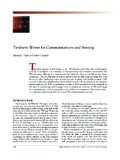Transcription of Current Technology of Laser Beam Profile Measurements
1 Current Technology of Laser Beam Profile Measurements Carlos B. Roundy, Spiricon, Inc. Logan, UT 84341 Phone: (435) 753-3729, Fax: (435) 753-5231, E-mail: 1. Introduction There are many applications of lasers in which the beam Profile is of critical importance. When the beam Profile is important, it is usually necessary to measure it to insure that the proper Profile exists. For some lasers and applications this may only be necessary during the design or fabrication phase of the Laser . In other cases it is necessary to monitor the Laser Profile continuously during the Laser operation. For example scientific applications of lasers often push the Laser to its operational limits and continuous or periodic measurement of the beam Profile is necessary to insure that the Laser is still operating as expected.
2 Some industrial Laser applications require periodic beam Profile monitoring to eliminate scrap produced when the Laser degrades. In other applications, such as some medical uses of lasers, the practitioner has no capability to tune the Laser , and the manufacturers measure the beam Profile in design to ensure that the Laser provides reliable performance at all times. However, there are medical uses of lasers, such as photo-refractive keratotomy, PRK, wherein periodic checking of the beam Profile can considerably enhance the reliability of the operation. PRK is an example of Laser beam shaping which is a process whereby the irradiance of the Laser beam is changed along its cross section.
3 In order for this Laser beam shaping to be effective, it is necessary to be able to measure the degree to which the irradiance pattern or beam Profile has been modified by the shaping medium. This paper describes the general state of the art of Laser beam Profile It introduces the general need for beam Profile analysis, methods for measuring the Laser beam Profile , a description of instrumentation that is used in beam Profile measurement, a discussion of the information that can be obtained simply by viewing the beam Profile , and finally, how quantitative Measurements are made on Laser beam profiles, and the significance of those quantitative Measurements .
4 2. Laser Beam Properties There are many common sources of light, each providing a different function. Table 1 lists some of these. For example, the sun provides 1000W/m2 on the surface of the earth, a very high power, but spread over a large area. A typical incandescent light bulb may put out 100 Watts, but is radiating into a sphere, and much of the light is in the infrared where it is not visible. A fluorescent light bulb, on the other hand, may put out only 40 Watts, but since more of the light is in the visible region, it illuminates objects about 3 times more efficiently than an incandescent bulb. Flood lamps or collimated light bulbs simply have reflectors to redirect the light into a specific direction.
5 Hot objects emitting radiation in the IR and near IR include everything around us: our own bodies, clouds overhead in the night, and all objects on the earth. Light emitting diodes produce light at fairly low intensity, but usually at specific wavelengths. Laser beams, on the other hand, produce light with many characteristics that are very unique to other sources of light. Table 1. Typical or common sources of light The sun A light bulb A collimated light bulb (flood lights) Hot objects Light emitting diodes A Laser beam Unique Laser Beam Characteristics Laser beams produce light with many characteristics that are very unique to other sources of light.
6 Some of the things that make Laser beams unique are listed in Table 2. For example, the monochromatic nature of a Laser beam means that it is typically a single narrow wavelength with very little light at wavelengths other than the central peak. The temporal nature of a Laser beam enables it to vary from a continuous wave to an extremely short pulse providing very high power densities. The coherence of a Laser enables it to travel in a narrow beam with a small and well defined divergence or spread. This allows a user to define exactly the area illuminated by the Laser beam. Because of this coherence a Laser beam can also be focused to a very small and intense spot in a highly concentrated area.
7 This concentration makes the Laser beam useful for many applications in physics, chemistry, the medical industry, and in industrial applications. Finally, a Laser beam has a unique irradiance Profile that gives it very significant characteristics. The beam Profile is a unique pattern of irradiance distribution across the beam. Table 2. Unique characteristics of a Laser beam Monochromatic (Single wavelength) Temporal (Continuous wave to femtosecond pulses) Coherence (Consistent phase between all light elements) Highly concentrated (Focusable to extremely small spots) Beam irradiance Profile (Unique spatial power or energy distribution) Significance of the Beam Profile The significance of the beam Profile is that the energy density, the concentration, and the collimation of the light are all affected by it.
8 Also the propagation of the beam through space is significantly affected by the beam Profile . Figure 1 shows a number of typical Laser beam profiles illustrating the variety that can exist. Since such a variety exists in Laser beam profiles, it is essential to measure the Profile in any application if the energy distribution affects the performance of the Laser or its intended purpose. Figure 1. Various Laser beam profiles: HeNe, Excimer, and Nitrogen Ring Laser . Examples of two different types of ideal Laser beams for different purposes are a Gaussian and a flat top beam. A Gaussian beam allows the highest concentration of focused light, whereas a flat top beam allows for very uniform distribution of the energy across a given area.
9 These two idealized beams are shown in Figure 2. 3 Figure 2a. Ideal Gaussian beam for Figure 2b. Ideal flat top beam for uniform Laser highest concentration of energy. illumination. Effects of Distorted Beam Profiles However, lasers rarely exhibit the most uniform irradiance Profile . Sometimes Gaussian beams are highly structured, and often-intended flat top beams are non-uniform across the top, or may be tilted in energy from one side to the other. Figure 3 illustrates some real world examples of distorted beam profiles. For example, in Figure 3a the highly structured beam would not focus nearly as well as the ideal Gaussian beam.
10 The tilted flat top beam of Figure 3b would not give uniform illumination as intended, and could cause severe distortion in the process for which it is being applied. Figure 3a. Highly structured Figure 3b. Tilted or non-uniform flat top beam. would-be Gaussian beam. Scientific Applications The significance of distorted beam profiles varies with the application. In scientific applications nonlinear processes are typically proportional to the irradiance squared or cubed. Thus a non-Gaussian Profile may have a peak energy as low as 50% of what a Gaussian beam would have under the same conditions of total power or energy. Therefore the nonlinear process may deteriorate to 25% or 12% of what is expected.





